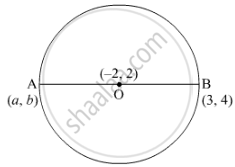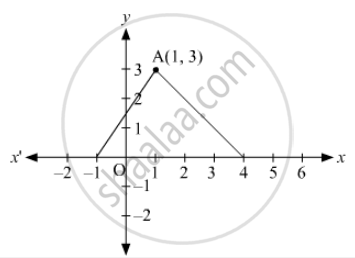Advertisements
Advertisements
Question
Find the coordinates of point A, where AB is a diameter of the circle with centre (–2, 2) and B is the point with coordinates (3, 4).
Solution

Let the centre of the circle be O.
Since AB is the diameter so, O is the midpoint of AB.
Thus, using the section formula,
`(a+3)/(2) = - 2`
⇒ `a = -4 - 3 = -7`
And
`(b + 4)/(2) = 2`
⇒ `b = 4 - 4 = 0`
So, the coordinate of point A is (-7,0).
APPEARS IN
RELATED QUESTIONS
(Street Plan): A city has two main roads which cross each other at the centre of the city. These two roads are along the North-South direction and East-West direction.
All the other streets of the city run parallel to these roads and are 200 m apart. There are 5 streets in each direction. Using 1cm = 200 m, draw a model of the city on your notebook. Represent the roads/streets by single lines.
There are many cross- streets in your model. A particular cross-street is made by two streets, one running in the North - South direction and another in the East - West direction. Each cross street is referred to in the following manner : If the 2nd street running in the North - South direction and 5th in the East - West direction meet at some crossing, then we will call this cross-street (2, 5). Using this convention, find:
- how many cross - streets can be referred to as (4, 3).
- how many cross - streets can be referred to as (3, 4).
Find the distance between the following pair of points:
(a, 0) and (0, b)
Find the value of k, if the point P (0, 2) is equidistant from (3, k) and (k, 5).
Three consecutive vertices of a parallelogram are (-2,-1), (1, 0) and (4, 3). Find the fourth vertex.
Find the ratio in which the line segment joining (-2, -3) and (5, 6) is divided by x-axis Also, find the coordinates of the point of division in each case.
If the point A (4,3) and B ( x,5) lies on a circle with the centre o (2,3) . Find the value of x.
Show that the points A(6,1), B(8,2), C(9,4) and D(7,3) are the vertices of a rhombus. Find its area.
Show that the points A(2,1), B(5,2), C(6,4) and D(3,3) are the angular points of a parallelogram. Is this figure a rectangle?
If the point P(k-1, 2) is equidistant from the points A(3,k) and B(k,5), find the value of k.
Find the coordinates of the points of trisection of the line segment joining the points (3, –2) and (–3, –4) ?
Find the coordinates of circumcentre and radius of circumcircle of ∆ABC if A(7, 1), B(3, 5) and C(2, 0) are given.
Find the value of k, if the points A (8, 1) B(3, −4) and C(2, k) are collinear.
If three points (x1, y1) (x2, y2), (x3, y3) lie on the same line, prove that \[\frac{y_2 - y_3}{x_2 x_3} + \frac{y_3 - y_1}{x_3 x_1} + \frac{y_1 - y_2}{x_1 x_2} = 0\]
Write the ratio in which the line segment doining the points A (3, −6), and B (5, 3) is divided by X-axis.
Find the distance between the points \[\left( - \frac{8}{5}, 2 \right)\] and \[\left( \frac{2}{5}, 2 \right)\] .
The distance between the points (a cos 25°, 0) and (0, a cos 65°) is
In Fig. 14.46, the area of ΔABC (in square units) is

The points whose abscissa and ordinate have different signs will lie in ______.
The distance of the point (–1, 7) from x-axis is ______.
